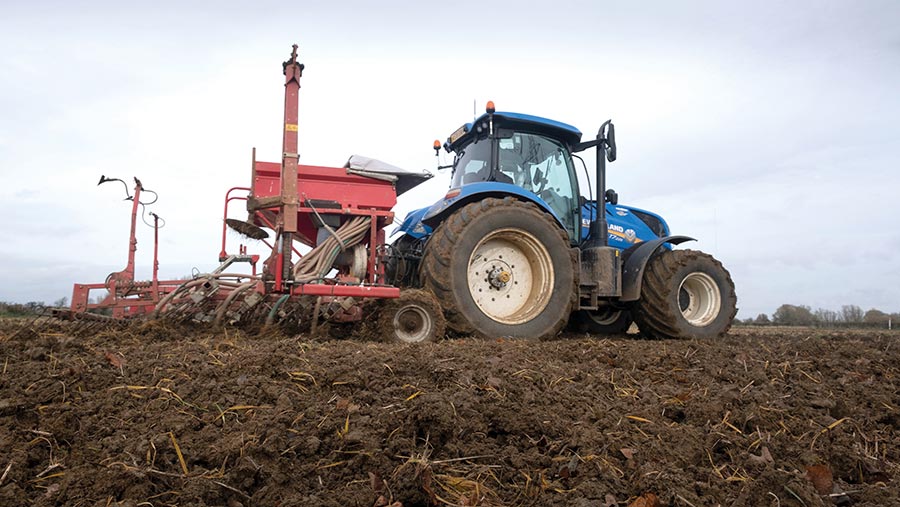5 steps to better winter bean establishment
 © Tim Scrivener
© Tim Scrivener Winter beans are often seen as a second-choice break crop behind oilseed rape, especially in challenging seasons such as 2023, but establish them well and they can still be a useful addition to the rotation, according to agronomy firm Hutchinsons.
Good establishment is fundamental to the success of any crop, and beans are no exception, regardless of whether they are broadcast onto the surface and ploughed in during November, or sown into good seed-beds with a precision drill, says Scotland-based technical support manager Cam Murray.
See also: Cropping beans helps Dorset grower in move to regen farming
Cam outlines five areas to focus on to give crops the best chance of success, and hopefully deliver a healthy margin next harvest.
Drilling date
Generally, winter beans should be sown from mid-October onwards, into November if soil conditions allow.
Indeed, Yield Enhanced Network (YEN) data shows higher yielding crops are generally sown later in the autumn.
“Soil moisture is important, but there needs to be residual warmth at the depth you’re drilling at too,” notes Cam.
“If soil is too cold [typically below 8C] and wet, bean seed will just sit there and rot, so there’s no point putting it in.”
If winter beans cannot be drilled before the weather window closes, growers should avoid the temptation to hold back seed and sow it in spring instead, he adds.
“Winter and spring beans are two totally different genetic varieties that act differently, so you’re asking for trouble if you try to sow winter beans in the spring, and vice versa.”
Seed rate and depth
Sowing the correct seed rate is crucial for winter beans, and Cam believes rates are sometimes too low to achieve the optimum plant population and yield.
In northern areas, growers should generally aim for 25-30 established plants per square metre, and be realistic about the seed rate required to achieve this, which will vary depending on establishment technique, seed-bed conditions, weather and thousand grain weight – which itself can vary hugely in beans, anywhere from 500-720g.
“Seed rates may differ considerably between the North and South, though. In southern parts of the UK, 12-15 beans/sq m established (in other words up in November) is often the target, otherwise crops may become far too thick by the spring,” says Cam.
“Typically, this means planting 18-22 seeds/sq m.”
Sowing depth is also important, and ideally beans should be sown 7.5-10 cm deep.
“If they are too shallow, beans won’t root properly and will be at greater risk of drought.
“Secondly, if they’re not deep enough, every crow in the neighbourhood will come along to dig them up.”
Nutrition
As with all crops, soils should have sufficient nutrients, notably phosphate and potash, to support healthy bean establishment.
Cam says good results have been achieved from the inclusion of protected phosphorus products, such as Primary-P, with seed at drilling to boost root growth and crop establishment.
Seed-bed
Where winter beans have been established by ploughing in, Cam says land should be levelled after ploughing with discs or rolling to reduce the risk of machine damage when travelling across uneven ground later in the season, and to improve the efficacy of pre-emergence herbicides.
If beans flower low down the plant, combining those lower pods can also be problematic where seed-beds have been left very uneven.
Weed control
Winter beans are not particularly competitive and can be slow to cover the ground, so effective weed control is essential.
“Weed control programmes are limited and certain weeds such as mayweed, chervil and cleavers can be an issue,” says Cam.
With only one approved post-emergence option, control hinges on applying an effective pre-em spray.
“You’ve really only got one shot, and that’s your pre-em residual weed control in the autumn,” he points out.
The armoury has been further reduced this season following the Chemicals Regulation Division’s decision to reclassify pulses as a major crop and remove extension of authorisation for minor use applications (Eamus) from major crops.
This means any chemistry that was based on an Eamu can no longer be used in winter beans, including all straight pendimethalin and prosulfocarb products.
There are three main options that remain, namely pendimethalin + imazamox, propyzamide, and clomazone, he says.
“We’re still waiting on the approval of aclonifen, which has been used elsewhere in Europe for 30 years, and also on other mixes that are still to come to market. So, at the moment, we’re limited to these three main options.”

